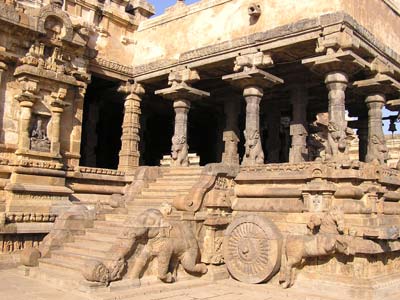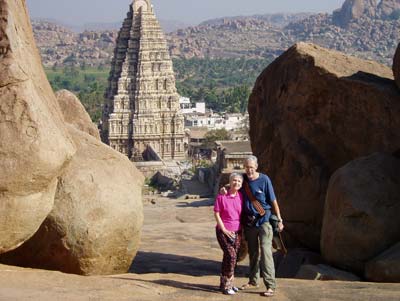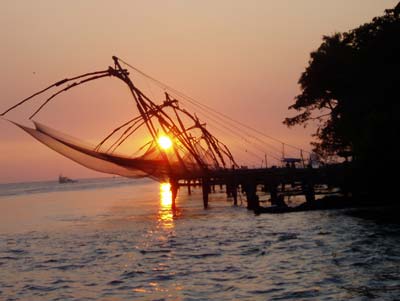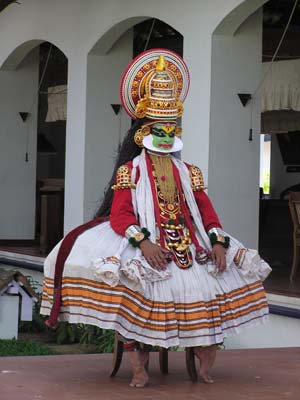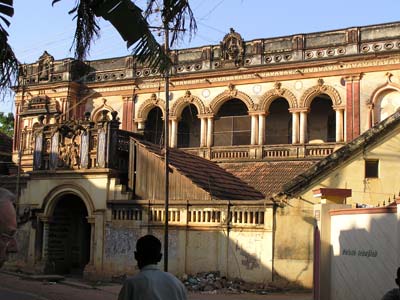The South of India — a good choice for the first-time visitor?
by Margo Wilson, Scottsdale, AZ
India is HOT! No, not that kind of hot, although you wouldn’t want to travel there in the summer. No, India is a hot, get-there-now travel destination. It is also economically hot, with one of the fastest-growing economies in Southeast Asia.
North versus south
The strides in economic development were apparent to us as we traveled for 23 days in southern India in January-February ’06, but the travel boom doesn’t seem to have hit that region yet. Although we met many independent British, Scandinavian and Swiss travelers who have made multiple trips to India, we met almost no Americans, and the lovely hotels we stayed in were frequented more by Indian travelers and businessmen than tour groups.
My husband and I and two of our friends had spent more than four weeks in India in 1996 visiting the major sites in the north. The enormous differences that we observed between that trip and this are partially explained by the differences in climate and topography and partially by the ethnic and political differences — and, surely, partly by the economic progress over the last 10 years.
We experienced lush tropical vegetation, spice farms, cool mountain and lake resorts, tea plantations and too many ancient temple complexes to keep track of. We also encountered clean streets, mostly good roads, absolutely no hard-sell hassling by vendors and virtually no begging.
Although the sites of southern India are not as well known, that area might be the better choice for the first-time visitor. Our trip, planned by me and tweaked by Nino Mohan of Worldview Tours (Newport Beach, CA; 800/373-0388, www.worldviewtours.com), included a large, air-conditioned van for the four of us, an absolutely wonderful, considerate, knowledgeable multilingual driver, Ramesh, and a guide for each of the two sections of the trip.
A trip like ours, without included lunches and dinners, was no more expensive than a group tour, and it allowed us to go when and where we wanted. It had the added benefit of keeping us from coming to the attention of overenthusiastic sellers of trinkets. Our land cost was $3,390 per person, not including meals, which ran around $22 per person per day.
Enjoying the drive
We began in Chennai (formerly Madras), where we stayed in the lovely Le Royal Méridien Hotel. After a morning city tour, we traveled one hour south to visit the monuments at Mahabalipuram, a UNESCO World Heritage Site. This group of temples and cave sanctuaries along the Coromandel coast was carved out of rock in the seventh and eighth centuries and is noted for its rathas, temples in the form of chariots.
We visited an evening dance festival at the temple site, one of only two places where we were bothered by mosquitoes on this trip. A short drive from Chennai, we stayed in a sea-view cottage at the first of several gorgeous Taj hotels, the Taj Fisherman’s Cove.
On the following day we traveled four hours to Pondicherry — one of our most interesting road journeys. Unlike on our trip 10 years ago, we felt perfectly safe on the roads on this trip due to better road conditions, less traffic and an excellent, careful driver.
Along the road, we observed huts built to house the fishermen displaced from the beach by the 2004 tsunami. There was much loss of life and property along this coast.
As we traveled, we saw brightly painted ox carts, 3-wheeled cabs, workers covering the road with grain to be thrashed by the vehicles passing over it, and lots of roadside activity.
Our driver knew every interesting photo op and stopped without being asked so that we could explore a family compound, a tribal temple and a weaving village. Arriving in Pondicherry, we found that its roots as a French settlement dating from 1674 were evident. A famous ashram, Auroville, is located nearby and was an interesting visit.
The Chettiars
Following Pondicherry, we visited a great number of huge 11th- and 12th-century Chola temple complexes, forts and palaces, many of which are UNESCO sites, located around Tanjore and Trichy. Along the way we also saw herons, a crocodile, monkeys, chipmunks and plantations of cashews, bananas and coconuts.
Our next stop was especially interesting, the area unknown to us until we researched it when planning our trip. Karaikudi and 74 other villages comprise the Chettinad region, the homeland of the Nattukottai Chettiars. A prosperous banking community, the Chettiars ventured overseas to do business in Southeast Asia in the 19th and early 20th centuries. Many lost their considerable fortunes in WWII, but evidence of their wealth is reflected in the fascinating mansions they built called bangala.
These mansions have to be seen to be believed. However, many are derelict, as some descendants cannot afford the upkeep while others simply don’t want to live in this rural area.
We stayed in a small hotel in Karaikudi, The Bangala, where we ate family style with the hostess/owner and learned more about the Chettiars. We also visited her family mansion and that of some friends of hers.
The British adopted the word “bangala,” transforming it into “bungalow,” but these homes are the opposite of bungalows as I know them; they are enormous, with a series of interior courtyards.
This area is also known for its cuisine, and our included meals were excellent.
On to Kerala
We made several more temple stops on the way to Madurai, the city of temples, a 3-hour drive from Karaikudi.
Here we stayed in another exceptional Taj hotel, overlooking the city and its famous Meenakshi Temple in the center of town. It is one of the biggest temples in India; one hall has nearly 1,000 individually carved columns, while the lower levels contain more than 4,000 granite sculptures. There are five pagodas known for their stucco work and musical pillars which, when struck, emit different tones.
We visited the temple for the evening ceremony of putting the gods to bed — the only time we experienced crowds — and again during the day.
We next traveled to Periyar National Park in the mountains of the Western Ghats, where we visited the spice, cashew, rubber, coffee and tea plantations and took a boat ride to see some wildlife.
The following day took us to one of the many highlights of this trip, an overnight on a houseboat on the backwaters of Kerala. These boats, called kettuvallam, are made from local materials like bamboo poles, coconut fiber, ropes and bamboo mats. Some are giant crafts as long as 60 to 70 feet.
The complex network of lagoons, lakes, rivers and canals we traveled gave us a glimpse of the regional lifestyle. Stops were made at small settlements where people live on carefully cultivated narrow spits of land only a few meters wide.
The end of our journey on Kerala’s waterway found us at a beautiful heritage hotel on the shore of a large lake, the Kumarakom Lake Resort, where our private villa was beside the meandering swimming pool that ran like a canal through the property.
Cochin
A short drive the next day brought us to Fort Cochin, the oldest section of Cochin, where our Brunton Boatyard Hotel room offered a view of the channel leading to the harbor with its constant stream of freighters, ferries, fishermen’s boats and the occasional cruise ship.
Only a few steps away was the area of the Chinese fishing nets, which we visited along with the St. Francis Church, where Vasco da Gama was buried before his remains were returned to Portugal, and small streets of interesting buildings, whose architecture reflected periods of Dutch, Portuguese and British colonization. Interestingly, as we drove through Kerala, the state in which Cochin is located, we saw very few Hindu temples but many churches and a few mosques.
Kerala is an interesting state with a government quite different from those of other Indian states. According to our guide, who was not from there, their government is less corrupt and more efficient and has provided greater affluence to its inhabitants than those of other states.
Another highlight was an evening visit to a Kathakali dance program, preceded by the opportunity to watch the actors apply their elaborate makeup. The dance program itself was short, tailored to the interest level of tourists; regular programs can last for hours.
Wayanad, a mountain resort, offered a stopping place to overnight and break up our drive to Mysore. Mysore’s palaces, fort, gardens, Catholic church and Hoysala temples are fascinating, but the market was the big attraction, for us; it wasn’t the first we had visited, but it was the largest and most interesting.
Winding down
Our last destination, after a long drive from Mysore on the worst roads of the trip but with interesting temples to visit along the way, was Hampi, a UNESCO World Heritage Site which contains royal palaces, pavilions, baths, guardhouses and elephant stables as well as a number of temples and ghats. These 500-year-old buildings and ruins are spread over 26 square kilometers of huge, round boulders interspersed with banana plantations, rice paddies and palm trees and bordered by the Tungabhadra River.
From the 14th century to the 16th, this was the enormous, powerful capital of the Vijayanagar Empire and it was surrounded by seven concentric lines of fortification. Our guide said that, at its height in the 1500s, it was second in size only to Rome.
Said to have had a population of half a million and a mercenary army of one million, it controlled the spice trade to the south and the cotton industry of the southeast; its bazaars were centers of international commerce where silks and precious gems were sold.
Today, it amazes the traveler with incredibly sculpted temples, colorful Hindu pilgrims, a fascinating and ever-changing panorama at the steps leading down to the river, and impressive buildings in the Royal Enclosure.
It’s difficult to single out only a few highlights of this site, though everyone must visit the beautiful Vitthala temple, which is, on its own, a World Heritage Monument. The elephant stable, with its domed roof, looked far too regal to house elephants!
A favorite of ours was the ghat — steps leading down to the river — where we observed an elephant being bathed, worshipers in the water, women in colorful saris carrying baskets of fruit or vegetables on their heads and a constant stream of people crossing the river in small boats. Our 6-hour visit barely touched the surface.
These wonders, enhanced by beautiful surroundings, require a lot of walking. Hampi and Cochin were the only places where we experienced really hot weather.
Our trip ended in the bustling, dynamically growing city of Bangalore, a major center of the tech industry, from where air connections are available to wherever you need to go. We went on to Australia, but that’s another story.
I’d be happy to answer any questions; e-mail me c/o ITN.



